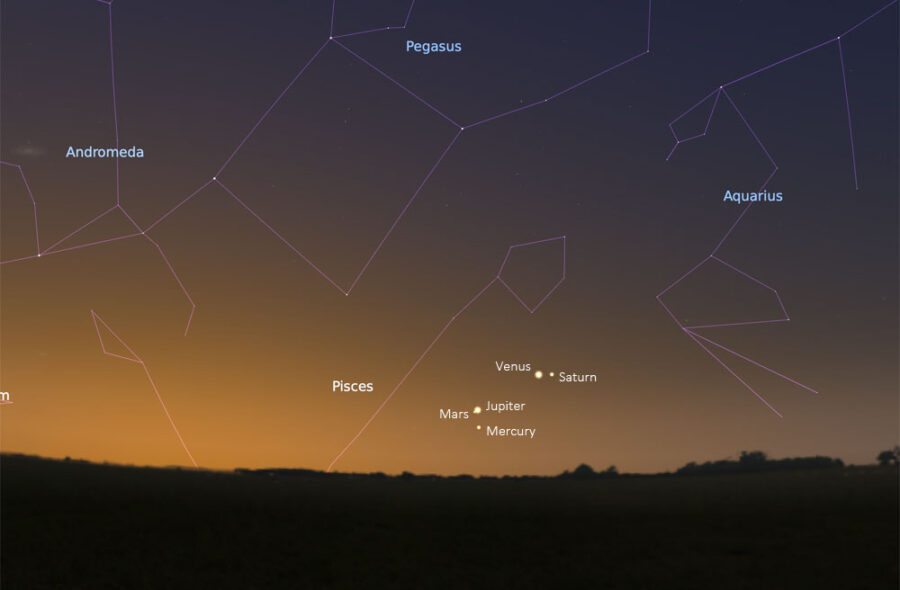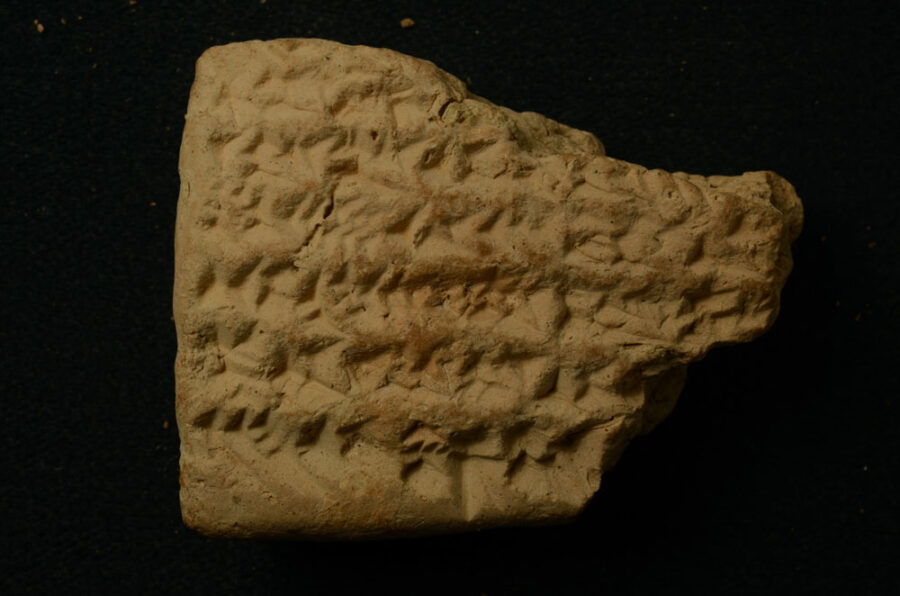Jupiter and Saturn’s “Great Conjunction” is a noteworthy event, but on the morning of March 25, 185 BC, an even grander planetary gathering greeted Babylonian sky watchers.

Stellarium
So you think the Great Conjunction of Jupiter and Saturn on December 21st is something special? Think again. Every five centuries on average, not just two but all five naked-eye planets can be seen close together in the sky.
A grand planetary gathering must have intrigued Babylonian sky watchers, who kept track of the motions of celestial bodies for astrological purposes. Dutch astronomer Teije de Jong (University of Amsterdam) and Austrian orientalist Hermann Hunger (University of Vienna) have now identified a small fragment of a clay tablet as a cuneiform description of a "massing of the planets" in 185 BC – the oldest (and only!) report of such an event known so far.
The fragment, known as BM 32562, measures only 36 by 46 millimeters. It describes observations of the morning sky over a period of 10 days at the start of month XII2 in the year 126 of the Seleucid Era, corresponding to 20–30 March, 185 BC.

Photo: Yasuyuki Mitsuma; courtesy Hermann Hunger
The closest grouping occurred on March 25th of that year, when Mercury, Venus, Mars, Jupiter and Saturn were positioned within just 7° of each other in the twilight sky in the constellation Pisces. For at least 10 minutes around 5:20 a.m. local time, all five planets would have been visible to the naked eye (a bit earlier, some of them had not yet risen high enough; a bit later, it became too bright to discern Mars and Saturn).
After identifying the events described on BM 32562, de Jong and Hunger discovered that the same “massing of the planets” is also described on another fragment, BM 46051. According to de Jong, both observers made some errors in the identification of the planets, occasionally mixing up Mercury, Mars and Saturn, which is not that surprising, given their low altitudes above the horizon and their similar brightness at that time (around 1st magnitude).
On the early morning of March 25, 185 BC, Mars and Jupiter were 9 arcminutes apart — not much farther than the 6 arcminutes that will separate Jupiter and Saturn this December 21st. Later that day, during full daylight, the two planets approached each other to within just 1 arcminute. Interestingly, the phrase “last part of the night, it was set towards its inside” on BM 32562 may indicate that the Babylonian astronomers were aware of this upcoming extremely close conjunction, as this description usually refers to an upcoming occultation of a normal star by the moon.
According to de Jong, the ancient astronomers could very well have made that prediction based on the planetary positions on the previous morning. “The fact that this exact conjunction between Mars and Jupiter appears to have been correctly predicted by the Babylonian scholars is a remarkable achievement and a nice illustration of their astronomical craftsmanship,” he and Hunger write in their paper in Archive for History of Exact Sciences.
Astronomy historian Bradley Schaefer (Louisiana State University), says he is excited by the prediction — and by the fact that Babylonians made two independent observations of the planetary movements in 185 B.C., with both of those records having survived to today on cuneiform tablets. “Hey, they were doing a lot better in old times than many would expect,” he says.
In the past 2,200 years, just four other observable massive planetary gatherings (the five naked-eye planets within 10 degrees of each other) have occurred: in late November 47 BC, early October AD 332, late June 710, and mid-September 1186. “It might be interesting to search for reports of one of these other events in late-Roman or Medieval archives,” says de Jong, “but that would be looking for a needle in a haystack, of course.”
 2
2
Comments
Chuck Hards
December 17, 2020 at 10:06 am
As a young man, I remember watching Uranus and Neptune get very close during their conjunction, both planets were easily visible in the same telescopic field of view for a short time. Truly a once-in-several-lifetimes occurrence.
Hoping for good weather on Monday night!
You must be logged in to post a comment.
Alain Maury
December 17, 2020 at 3:14 pm
Govert, the past is interesting, but the future is also quite interesting.
The next great conjunction is for October 31st 2040... But... on September 8, 2040, a few weeks earlier, you have another of these incredible grouping of solar system objects, since Mercury, Venus, the Moon, Mars, Jupiter and Saturn will be contained in a circle 9°18' wide and Jupiter will be less than 10 arc minutes away from Venus.
And this one, weather and life permitting I will observe.
In 2011 I wrote a page about this, it's in french, but google translate will help you. Look at the bottom of the page. At the time I wrote the page because of the craze concerning planetary alignments, mayas end of the world, alignment of the sun with the central black hole of the galaxy, and other stupidities, to show that the years where we had had "planetary alignments", nothing happened.
http://www.spaceobs.com/fr/Blog-de-Alain-Maury/Textes/Textes-pour-mecreants-Les-alignements-planetaires
Hope all is well in Netherlands.
Alain
You must be logged in to post a comment.
You must be logged in to post a comment.